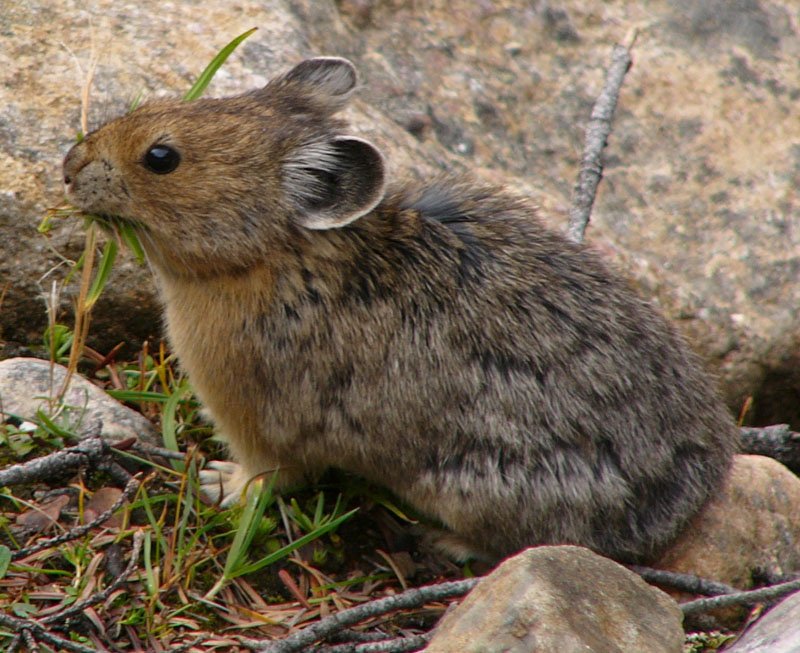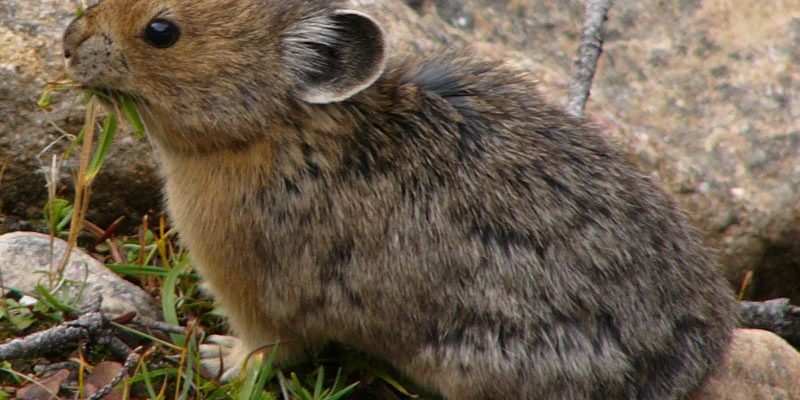
Imagine a tiny creature that looks like a blend between a rabbit and a mouse, scurrying around the rocky mountain slopes. This adorable little critter is known as the American Pika, and it’s one of nature’s fascinating wonders. Living high in the mountains of the western United States and Canada, these playful animals play a crucial role in their ecosystem. While they may be small, their impact is mighty!
American Pikas are not just cute; they’re also incredibly resilient. These small mammals belong to the family Ochotona, which is closely related to rabbits and hares. They are best known for their distinctive vocalizations, which sound almost like a high-pitched whistle. If you’ve ever hiked in the mountains and heard those little chirps, now you know who you were listening to! Let’s dive deeper into the world of the American Pika and discover what makes them so special.
Physical Characteristics
The American Pika is a small mammal that measures around 7 to 9 inches in length, with a weight of about 5 to 7 ounces. At first glance, you might mistake them for oversized hamsters, but they have unique features that set them apart. Pikas have rounded ears, short limbs, and a short tail. Their fur is thick and soft, typically grayish-brown, providing excellent insulation against the chilly mountain air.
One striking characteristic of the American Pika is their ability to adapt to extreme weather conditions. They have specialized anatomical features that help them survive temperature fluctuations. Their dense fur keeps them warm in winter, while their small size allows them to hide in rock crevices during the heat of summer. It’s almost as if they were designed for the rugged mountain environments they call home.
These little mammals also have a unique way of communicating and expressing themselves. They use a series of high-pitched calls to alert each other of nearby dangers. It’s a bit like having a built-in alarm system! Their vocalizations are not just for warning; they also play a crucial role in social interactions, helping Pikas maintain their social structures within their colonies.
Habitat of the American Pika
The habitat of the American Pika is typically rocky, alpine regions. These areas provide the perfect combination of shelter and food. Pikas are skilled at navigating the boulders and cliffs of these mountainous terrains, where they build their homes in rocky crevices. This rocky environment not only protects them from larger predators but also serves as an ideal place to store food.
You might be curious about where exactly these cute little creatures live. American Pikas are primarily found throughout the western United States, from the Sierra Nevada in California to the Rocky Mountains and even parts of Canada. They prefer elevations between 5,000 and 13,000 feet, where the climate is cooler, and the vegetation is rich.
What’s fascinating is how climate change has started impacting their habitat. As temperatures rise, some Pika populations are migrating to higher altitudes, while others are struggling to adapt. This shift could affect their survival and the overall health of the ecosystems they inhabit. It’s a poignant reminder of how interconnected all living beings are. Protecting their habitat is crucial for ensuring their survival.
Diet and Foraging Behavior
The American Pika is an herbivore, primarily relying on a diet of grasses, herbs, and flowers. They are especially fond of foraging in the summer months when food is abundant. Pikas have a unique foraging strategy, as they collect and store food in their rocky homes, creating “haypiles” for the winter months. This habit is crucial for their survival, as it allows them to have a steady food supply when the snow covers the ground.
When foraging, Pikas are selective eaters. They choose nutrient-rich plants that will help sustain them during the colder months. Some of their favorite snacks include dandelions, clovers, and various mountain flowers. You wouldn’t believe how much they can gather! During peak foraging times, they can collect several pounds of plant material, carefully transporting it back to their homes.
This food storage behavior is not just about survival; it’s a testament to their resourcefulness. They aren’t just hoarding; they’re planning for the future, making sure they have enough to eat when resources are scarce. This instinct to gather and store food reflects their deep connection to their environment and highlights their role as an important player in the alpine ecosystem.
Reproduction and Lifespan
American Pikas typically breed once a year, with females giving birth to litters of 2 to 6 young. The breeding season usually occurs in late spring or early summer. After a gestation period of about 30 days, the tiny Pika babies, or kits, are born blind and hairless, relying on their mothers for warmth and nourishment. This nurturing behavior emphasizes the importance of family bonds in Pika communities.
The young Pikas start to venture out of their burrows at around 3 weeks old, quickly learning how to forage for food and communicate with their family. They grow rapidly and become independent within a month. However, some young Pikas might stay close to their mothers, helping with food gathering and learning the ins and outs of their habitat.
In terms of lifespan, American Pikas can live up to 5 to 7 years in the wild. While their lives may seem short, they make a significant impact during that time. Their roles as herbivores help shape their ecosystem, influencing plant communities and providing food for predators such as hawks and weasels. Every little Pika contributes to the delicate balance of life in the mountains.
Conservation Status
As charming as they are, the future of the American Pika is uncertain. Climate change poses a significant threat to their populations. Rising temperatures can lead to habitat loss and decreased food availability, disrupting their delicate survival strategies. Pikas are considered an indicator species, meaning their health reflects the state of their environment. If they’re struggling, it’s a sign that something is off in the ecosystem.
Conservation efforts are underway to protect these little mammals and their habitats. Organizations are working to monitor Pika populations and study how they’re adapting to climate change. Public awareness is also vital. By educating people about the American Pika, we can promote conservation initiatives and encourage everyone to appreciate these unique creatures.
Interestingly, Pikas have a remarkable ability to adapt to cold temperatures. They have even been observed climbing to greater altitudes to escape warming temperatures. However, this comes with limitations, as not all populations can migrate or find suitable new habitats. The Pika’s plight serves as a powerful reminder of the importance of preserving our natural environments and the species that inhabit them.
| Characteristic | Details |
| Size | 7–9 inches long |
| Weight | 5–7 ounces |
| Habitat | Rocky alpine regions |
| Diet | Grasses, herbs, and flowers |
| Reproductive Rate | 2–6 kits per litter |
| Lifespan | 5–7 years in the wild |
Interesting Facts About American Pikas
Did you know that American Pikas have a unique way of dealing with the cold? They often create massive haypiles to ensure they have enough food during winter. Their ability to adapt to harsh conditions is truly impressive! Pikas are also known to be quite vocal, using a variety of sounds to communicate with each other—think of it as their own little language, unique to the mountains.
Another neat fact is that Pikas do not hibernate. Instead, they are active year-round, making their foraging strategies all the more important. They have evolved to store food for those long winter months but remain alert and ready to scurry around even in the snow. Their resilience is indeed a true testament to their survival skills.
Lastly, despite their small size, these little mammals play a large role in their ecosystem. By foraging and clipping plants, they help maintain the health of their mountain habitats. Their activities promote plant diversity and create a vibrant environment for other wildlife. Isn’t it amazing how such a small creature can make such a huge impact?
FAQ
What is an American Pika’s primary habitat?
The American Pika primarily inhabits rocky, alpine regions that provide shelter and food. These environments are typically found at high elevations in the western United States and Canada. They thrive in the cool, mountainous climate, which is crucial for their survival.
How does climate change affect American Pikas?
Climate change poses a significant threat to American Pikas by altering their habitat. As temperatures rise, they are forced to move to higher elevations or face habitat loss. This can disrupt their food supply and reproductive patterns, ultimately impacting their populations.
What do American Pikas eat?
American Pikas are herbivores, primarily feeding on grasses, herbs, and flowers. They have a habit of foraging during the summer and storing food in haypiles for the winter months to ensure a steady food supply when resources are scarce.
How do American Pikas communicate?
American Pikas communicate through a series of high-pitched calls. These vocalizations serve multiple purposes, including warning others of predators and facilitating social interactions within their colonies. Their unique sounds contribute to the community dynamics among Pikas.
How long do American Pikas live?
In the wild, American Pikas typically live for about 5 to 7 years. Their lifespan can be influenced by various factors, including predators, environmental conditions, and availability of food resources.
Are American Pikas social animals?
Yes, American Pikas can be quite social. They often live in colonies and engage in social behaviors, including vocal communication and foraging together. However, they are not as social as some other rodent species and can also be territorial.
What adaptations help American Pikas survive in cold climates?
American Pikas have several adaptations that help them thrive in cold climates. Their dense fur provides insulation, while their ability to forage and store food ensures they have enough nutrition during harsh winter months. They also have a unique way of navigating rocky terrains, which helps them avoid predators.
Can American Pikas swim?
While American Pikas are not known for swimming, they are excellent climbers and are quite agile in their rocky habitats. They thrive in their mountainous environments but are not adapted for aquatic life.
How do Pikas contribute to their ecosystem?
American Pikas play a vital role in their ecosystem by foraging and clipping plants, which helps maintain plant diversity and health. Their activities can promote a vibrant environment for other wildlife, making them essential contributors to the alpine ecosystems in which they live.

